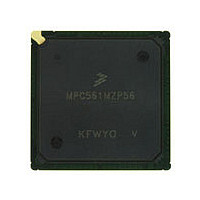MPC561MZP56 Freescale, MPC561MZP56 Datasheet - Page 427

MPC561MZP56
Manufacturer Part Number
MPC561MZP56
Description
Manufacturer
Freescale
Datasheet
1.MPC561MZP56.pdf
(1420 pages)
Specifications of MPC561MZP56
Cpu Family
MPC56x
Device Core
PowerPC
Device Core Size
32b
Frequency (max)
56MHz
Interface Type
QSPI/SCI/SPI/UART
Total Internal Ram Size
32KB
# I/os (max)
56
Number Of Timers - General Purpose
22
Operating Supply Voltage (typ)
2.6/5V
Operating Supply Voltage (max)
2.7/5.25V
Operating Supply Voltage (min)
2.5/4.75V
On-chip Adc
2(32-chx10-bit)
Instruction Set Architecture
RISC
Operating Temp Range
-40C to 125C
Operating Temperature Classification
Automotive
Mounting
Surface Mount
Pin Count
388
Package Type
BGA
Program Memory Type
ROMLess
Program Memory Size
Not Required
Lead Free Status / RoHS Status
Not Compliant
Available stocks
Company
Part Number
Manufacturer
Quantity
Price
Company:
Part Number:
MPC561MZP56
Manufacturer:
Freescale Semiconductor
Quantity:
10 000
Company:
Part Number:
MPC561MZP56R2
Manufacturer:
Freescale Semiconductor
Quantity:
10 000
- Current page: 427 of 1420
- Download datasheet (11Mb)
Because it takes two clocks for the external address to be recognized and handled by the memory
controller, the TS which is generated by the external master is ahead of the corresponding CS and strobes
which are asserted by the memory controller. This 2-clock delay might cause problems in some
synchronous memories. To overcome this, the memory controller generates the MTS (memory transfer
start) strobe which can be used in the slave’s memory instead of the external master’s TS signal. As seen
in
the external memory can latch the external master’s address correctly. To activate this feature, the MTSC
bit must be set in the SIUMCR register. Use external logic to control devices that can have burst accesses
from an external master.
On the MPC563, when the external master accesses the internal Flash when it is disabled, the access is
terminated with the transfer error acknowledge (TEA) signal asserted, and the memory controller does not
support this access in any way.
When the memory controller serves an external master, the BDIP signal becomes an input signal. This
signal is watched by the memory controller to detect when the burst is terminated.
Freescale Semiconductor
Figure
NOTE: The memory controller’s BDIP line is used as a burst_in_progress signal.
10-20, the MTS strobe is synchronized to the assertion of CS by the memory controller so that
MPC5xx
Address
BURST
WE/BE
MTS
BDIP
Data
TS
CSx
TA
OE
Configuration for GPCM-Handled Memory Devices
Figure 10-20. Synchronous External Master
TA
MPC561/MPC563 Reference Manual, Rev. 1.2
TS
Synchronous External Master
BDIP
Data
ADDR
BURST
BDIP
BURST
TS
CE
OE
W
Data
Address
Memory
Memory Controller
10-29
Related parts for MPC561MZP56
Image
Part Number
Description
Manufacturer
Datasheet
Request
R

Part Number:
Description:
MPC5 1K0 5%
Manufacturer:
TE Connectivity
Datasheet:

Part Number:
Description:
MPC5 500R 5%
Manufacturer:
TE Connectivity
Datasheet:

Part Number:
Description:
MPC5 5K0 5%
Manufacturer:
Tyco Electronics
Datasheet:

Part Number:
Description:
MPC5 5R0 5%
Manufacturer:
Tyco Electronics
Datasheet:

Part Number:
Description:
MPC5 50K 5%
Manufacturer:
Tyco Electronics
Datasheet:

Part Number:
Description:
MPC5 1R0 5%
Manufacturer:
Tyco Electronics
Datasheet:

Part Number:
Description:
TOWER ELEVATOR BOARDS HARDWARE
Manufacturer:
Freescale Semiconductor
Datasheet:

Part Number:
Description:
TOWER SERIAL I/O HARDWARE
Manufacturer:
Freescale Semiconductor
Datasheet:

Part Number:
Description:
LCD MODULE FOR TWR SYSTEM
Manufacturer:
Freescale Semiconductor
Datasheet:

Part Number:
Description:
DAUGHTER LCD WVGA I.MX51
Manufacturer:
Freescale Semiconductor
Datasheet:

Part Number:
Description:
TOWER SYSTEM BOARD MPC5125
Manufacturer:
Freescale Semiconductor
Datasheet:












